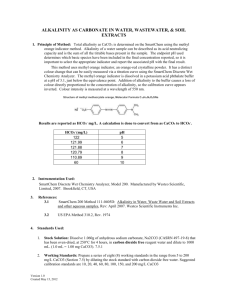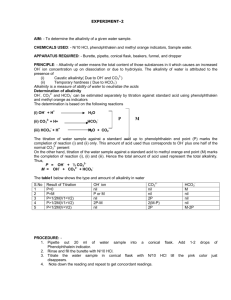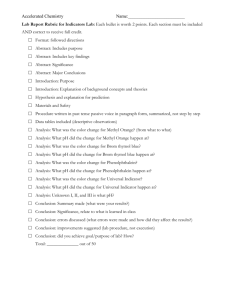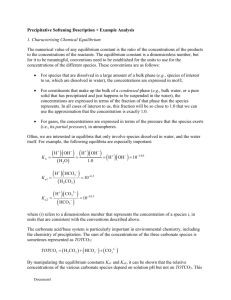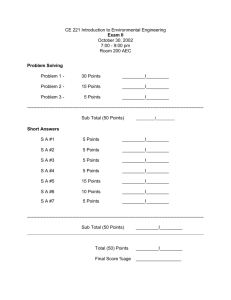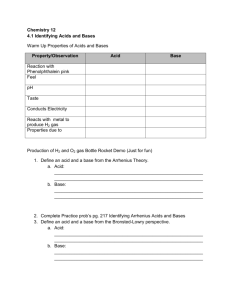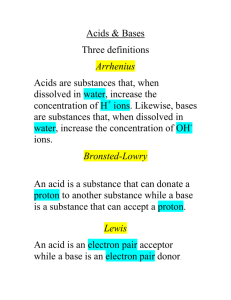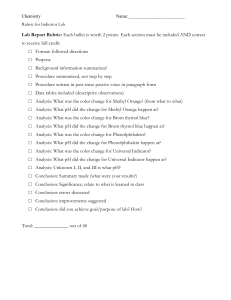Expt 1-Alkalinity of water sample
advertisement
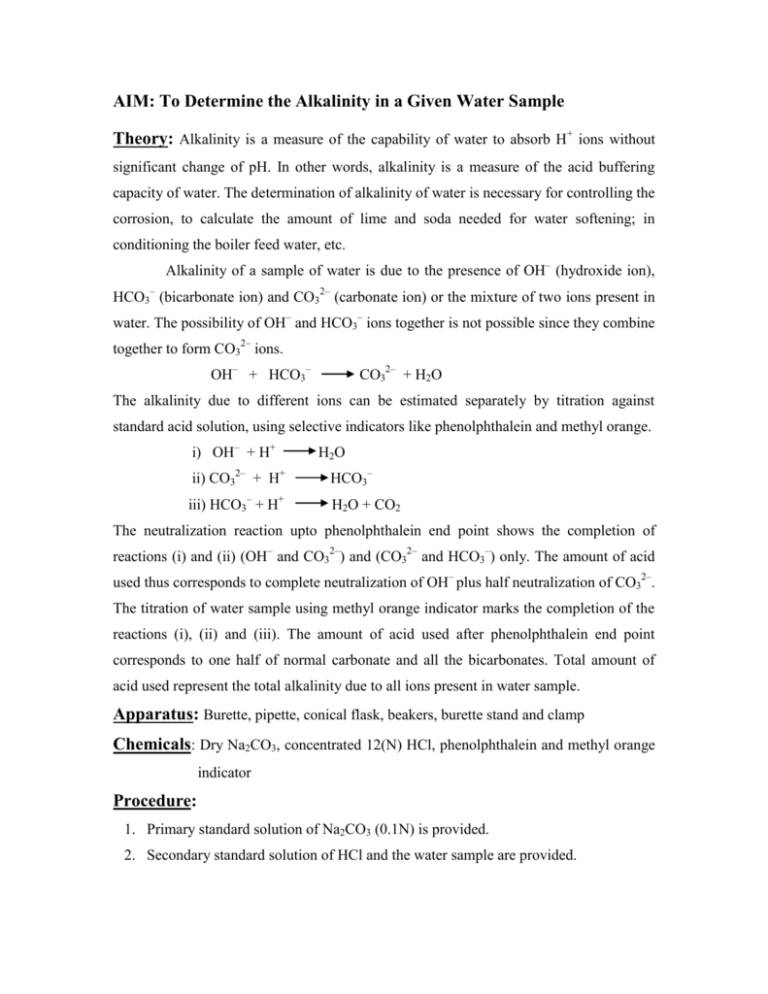
AIM: To Determine the Alkalinity in a Given Water Sample Theory: Alkalinity is a measure of the capability of water to absorb H+ ions without significant change of pH. In other words, alkalinity is a measure of the acid buffering capacity of water. The determination of alkalinity of water is necessary for controlling the corrosion, to calculate the amount of lime and soda needed for water softening; in conditioning the boiler feed water, etc. Alkalinity of a sample of water is due to the presence of OH– (hydroxide ion), HCO3– (bicarbonate ion) and CO32– (carbonate ion) or the mixture of two ions present in water. The possibility of OH– and HCO3– ions together is not possible since they combine together to form CO32– ions. OH– + HCO3– CO32– + H2O The alkalinity due to different ions can be estimated separately by titration against standard acid solution, using selective indicators like phenolphthalein and methyl orange. i) OH– + H+ ii) CO3 2– H2O + + H iii) HCO3– + H+ HCO3– H2O + CO2 The neutralization reaction upto phenolphthalein end point shows the completion of reactions (i) and (ii) (OH– and CO32–) and (CO32– and HCO3–) only. The amount of acid used thus corresponds to complete neutralization of OH– plus half neutralization of CO32–. The titration of water sample using methyl orange indicator marks the completion of the reactions (i), (ii) and (iii). The amount of acid used after phenolphthalein end point corresponds to one half of normal carbonate and all the bicarbonates. Total amount of acid used represent the total alkalinity due to all ions present in water sample. Apparatus: Burette, pipette, conical flask, beakers, burette stand and clamp Chemicals: Dry Na2CO3, concentrated 12(N) HCl, phenolphthalein and methyl orange indicator Procedure: 1. Primary standard solution of Na2CO3 (0.1N) is provided. 2. Secondary standard solution of HCl and the water sample are provided. 3. Standarization of HCl solution by primary standard Na2CO3 solution– Pipette out 10 mL of Na2CO3 solution in a conical flask, add 2 drops of methyl orange indicator, fill up the burette with (N/10) HCl solution and titrate till the color of the solution changes from yellow to red. 4. Analysis of water sample i) Pipette 20 mL of the sample of water into a 100 mL conical flask and 2 drops of phenolphthalein indicator was added and titrated against (N/10) HCl till the color of the solution changes from pink to colorless. Corresponding burette reading indicates the phenolphthalein end point (V1). ii) Again pipette out 20 mL of the water sample in a conical flask, add 2 drops of methyl orange indicator. Color of the solution becomes yellow. Continue the titration against the (N/10) HCl solution till the color changes to red. This burette reading corresponds to the methyl orange end point (V2). Observations and Calculations Table 1:- Standardization of HCl solution Strength of Na2CO3 solution (S1) = 0.1(N) Entry 1. 2. 3. Volume of Na2CO3 solution (V1 ) (mL) 10 10 10 Burette Reading (mL) Initial Final Volume of HCl required (mL) Mean volume of HCl required (V2) (mL) Let, the strength of HCl = S2 As we know, V1S1=V2S2 S2=(V1S1/V2) (N) Table 2:- Analysis of water using phenolphthalein indicator Strength of HCl solution (S2) = ____ (N) Entry Volume of Water Sample Taken (mL ) 1. 20 Burette Reading (mL) Initial Final Volume of HCl required (mL) Mean volume of HCl required (V4) (mL) 2. 3. 20 20 20 x S3 = V4 x S2 S3 = (V4 x S2 )/ 20 where S3 is the phenolphthalein alkalinity in water sample Strength in terms of CaCO3 equivalent = S3 x Eq. Wt of CaCO3 = (V4S2 / 20) x 50 g/L = A (say) g/L Phenolphthalein alkalinity (P) = A x 1000 mg/L Table 3:- Analysis of water using methyl orange indicator Entry Volume of Water Sample Taken (mL ) 1. 2. 3. 20 20 20 20 x S4 = V5 x S2 S4 = (V5S2/20) Burette Reading (mL) Initial Final Volume of HCl required (mL) Mean volume of HCl required (V5) (mL) where, S4 is the methyl orange alkalinity in water sample Strength in terms of CaCO3 equivalent = S4 x Eq. Wt. of CaCO3 = (V5S2/20) x 50 g/L = B (say) g/L Methyl orange alkalinity (M) = B x 1000 mg/L Conclusion: P ˃ ½M Both OH– and CO32– ions are present in the water sample. Discussions: i) Phenolphthalein alkalinity (P) = 0; that means the volume of acid used till the completion of reaction (i) and (ii) is 0. This can only happen when both OH– and CO32– ions are not present in water. Alkalinity is present due to HCO3– ion only which can be determined using methyl orange indicator and called methyl orange alkalinity (M). ii) P = ½ M; indicates that only CO32– ions are present. Using phenolphthalein indicator neutralization reaches upto HCO3– but using methyl orange indicator the complete neutralization of HCO3– takes place. iii) P > ½M; implies OH– ions are also present along with CO32– ions. Upto phenolphthalein alkalinity OH– ions will be neutralized completely where as CO32– will be neutralized upto HCO3– ion. But using methyl orange indicator HCO3– will be completely neutralized along with OH– and CO32–. iv) P < ½ M; indicates that beside CO32– ions HCO3– ions are also present. The volume of acid required for the neutralization upto phenolphthalein end point correspond half neutralization of CO32– (equation ii). Neutralization using methyl orange indicator corresponds to HCO3– obtained from CO32– and HCO3– originally present in the water sample. v) P = M; indicates only OH– ions are present. Precautions: i) All the glass apparatus should be washed thoroughly with distilled water before use ii) The burette and pipette should be rinsed with solution to be taken in it. iii) There should not be any leakage in the burette. iv) The conical flask should be placed on white paper or board to identify the colour change at the end point.
